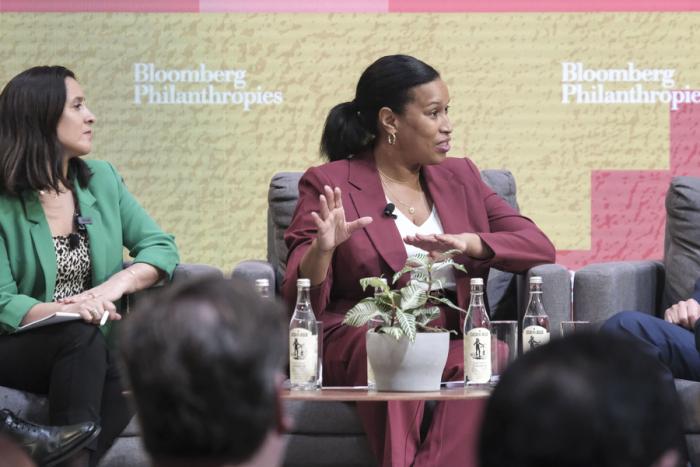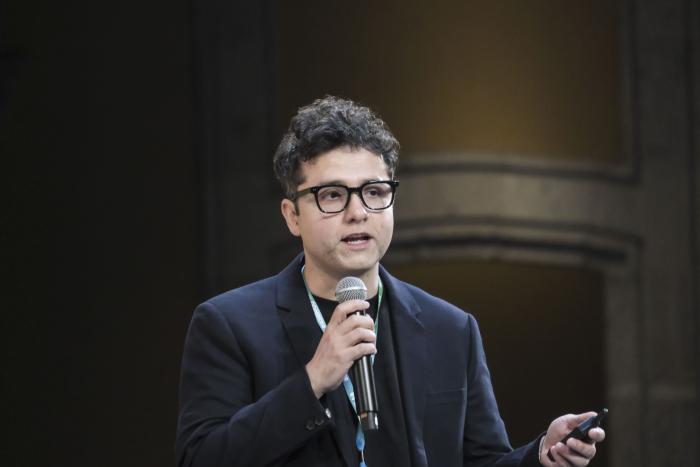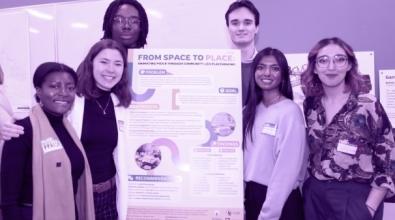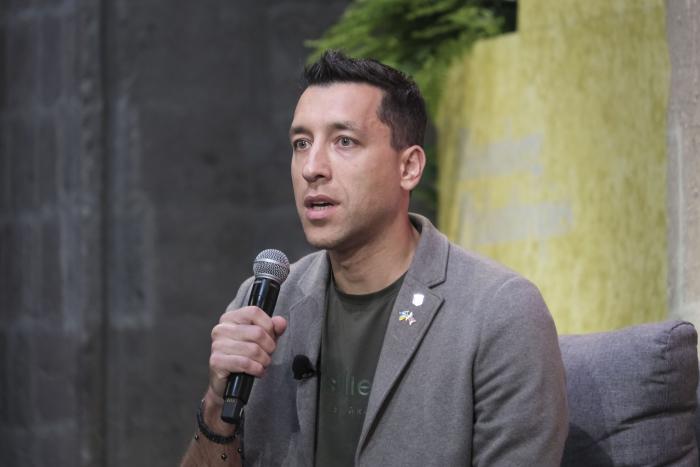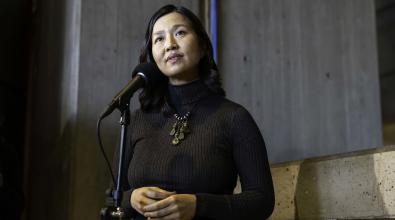 Read More
Read More
Beyond the noise: How to engage residents effectively
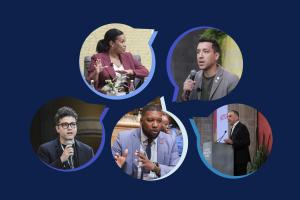
Photos courtesy of Bloomberg Philanthropies
Listen to This Article
More than ever before, mayors face tremendous obstacles in communicating with the people they serve. According to a recent Bloomberg Philanthropies survey, 60 percent of mayors believe polarization in their cities is “more extreme than ever.” Forty-four percent say they lack sufficient feedback loops with residents, and—with local news outlets vanishing across the world—53 percent report a struggle to wade through the maze of an increasingly fragmented media landscape that’s rife with misinformation.
At the same time, some 58 percent of the 85 mayors who participated in the Bloomberg survey say they want their city to find more innovative ways to respond to these challenges. It was with that critical work in mind that more than 100 global mayors recently came together for a Mayors Innovation Studio at Bloomberg CityLab 2024 in Mexico City. The objective was clear: “We need to innovate the way we engage the public,” said James Anderson, who leads the Government Innovation program at Bloomberg Philanthropies.
Here are the key strategies the mayors explored as they worked together to level up their engagement with residents.
Leading with authenticity.
Because people today have countless media options to choose from, it’s vital that mayors looking to connect with them on messaging start with a foundation of authenticity.
What this looks like in practice is making efforts while crafting messaging—and especially multimedia products—to capture the look, sound, and feel of the place residents know. And one very straightforward way to do that is to tap city employees and give them an opportunity to broadcast their own personalities in service of local priorities.
For example, in Bratislava, Slovakia, Mayor Matúš Vallo was determined to show that the city was effectively spending public funds on a new maintenance agency after local leaders had previously outsourced that work. Vallo needed to build trust that the government was being efficient and productive. So rather than just issuing a press release, his office produced a series of engaging, funny, and—most of all—genuine videos set to pop music that spotlighted municipal employees (and one charismatic employee in particular) at work. Far from stilted and staged recitations of scripted statements, the videos are rife with jokes and, at the same time, convey pride and a sense of place.
“We’re using [fun] as an instrument” of engagement, Vallo tells Bloomberg Cities, emphasizing how inexpensive the videos (shot on smartphones by in-house personnel) were to produce. Importantly, he adds, the videos use a human touch to convey authenticity—and deliver critical messages about public dollars being well-spent.
Listening before honing a relatable city-wide voice.
As they work to better connect with residents, mayors can benefit from making real efforts to listen first in order to develop and fine-tune a local voice that resonates with the people who know their city best.
“A clear voice is the most powerful engagement tool” out there, explained Felipe Ribeiro, the advertising firm Wieden and Kennedy's chief creative officer in Portland whose team works regularly with city leaders there, and who engaged with the mayors gathered in Mexico City. “It shows the belief you share with your audience.”
He offered an example from the New York City Department of Sanitation, which uses its social-media channels to playfully jab at local businesses that appear to be violating waste-disposal policies with colorful, acerbic posts on platforms such as Instagram. The agency is deliberate about avoiding jargon and, instead, capturing the cadence actual residents use with each other.
To establish and perfect that voice, Ribeiro proposed a few critical steps to take. First, he said, leaders can take time to identify what it is people are most proud of about their city. And it might not be a purely positive trait—he gave the example of the nickname “concrete jungle” for New York City. Residents may admire the messy chaos that defines where they live. Leaders can embrace that, rather than attempting to sanitize their city’s voice.
Next, cities can look to popular figures for inspiration or even as spokespeople; these might be cultural icons such as musicians or athletes. At the same time, Ribeiro advised that cities give their various agencies and institutions license to experiment; a city’s tone of voice can and should change—just as it does for residents—depending on the topic at hand.
Finally, leaders can deploy their honed voice to bring their ideas and vision to life, activating it in service of critical priorities. “If you speak with the voice of your city, you speak with the city—and the city sees you as one of them,” Ribeiro said.
Experimenting with non-traditional platforms.
With news outlets losing reach and residents’ trust in them fading, another way mayors can break through is by thinking anew about publishing platforms beyond the city website, the press release, and the news media.
In Nairobi, that means meeting residents where they are by pushing out short video clips about local initiatives—including efforts to address child poverty, for example—through WhatsApp. By doing so, they've found the people the city shares these video clips with end up sharing them with their own networks. “So instead of me sending it to you, it's your cousin sending it to you, or your mother sending it to you, and it becomes more than just the governor, you know, speaking down to you,” Governor Sakaja Johnson, who leads the local government, explained.
This is part of a larger strategy to engage residents where they consume information, rather than through the platforms the city may be most familiar with. For Gov. Johnson, that also means communicating through lifestyle radio shows, and not just the news programs with which residents may have disengaged in recent years.
“What we’ve realized is that people listen more to people who sound like them and who look like them more than the experts,” Johnson said.
Tapping digital capacity to cut through the misinformation.
No generation of leaders has faced a media landscape like today's, one that is littered with unprecedented levels of misinformation. Yet, at the same time, no generation of leaders has been equipped with the digital capacity that today's leaders have at their disposal. And that capacity, in and of itself, is an important tool when it comes to effectively engaging with residents.
For Kyiv, that means tapping a city-run digital platform originally created before the war in Ukraine to provide access to services such as parking and public transit to now offer everything from warnings about missile attacks to maps of bomb shelters to schedules of electricity outages.
According to Oleg Polovynko, advisor to the city’s mayor on digitalization, the strategy has an added benefit: residents can better trust the information they get from the local government than what they might find from other sources. "Social media can be manipulated,” he said, recalling misinformation spreading about the Russians having seized Kyiv early in the war when the city’s official websites had come under attack, too.
Of course, effective communication is rarely one-directional. That's why Kyiv responded to resident requests for accurate information about which local businesses were still open by asking its citizens to provide that raw intelligence themselves. This two-way process helped reinforce the legitimacy of the platform the city uses to convey official messages.
While most cities don’t face the same sorts of challenges as Kyiv, Polovynko stressed that every city can develop a “trustable channel of communication” so that when a crisis does hit, they’re ready. And besides, Kyiv still finds plenty of ways to use its electronic communication channel that may be more familiar to other mayors, such as for petitions to rename streets (in Kyiv’s case, to leave behind their Russian past).
“Before the invasion, we wanted to involve our residents in decisions,” Polovynko said. Now, the city has gone further, to what he calls “electronic democracy.”
Going forward, it’s perhaps most incumbent on mayors to embrace the same level of risk and experimentation when communicating that they take when devising innovative new solutions. As Luke McGowan of Bloomberg Philanthropies put it to mayors at the conclusion of the session in Mexico City, “We don't have to wait for the crisis to come to us” to start building trusted channels with residents.
For additional tools and resources on navigating the evolving information landscape from the Shorenstein Center on Media, Politics and Public Policy at the Harvard Kennedy School, click here.
